Page 309 - IJB-10-4
P. 309
International Journal of Bioprinting PCL/Fe3O4@ZIF-8 for infected bone repair
(OCN), was detected by means of real-time polymerase 2.11. Antibacterial activity and bone defect repair
chain reaction (RT-PCR) and Western blotting. To further assessment in vivo
explore the role of Wnt/β-catenin pathway in osteogenic To evaluate the antibacterial activity of the scaffolds in
differentiation ability of BMSCs co-cultured with scaffolds, vivo, the scaffolds were respectively embedded in the
the expressions of related genes and proteins were also subcutaneous tissue of left dorsum and cranial critical
detected by RT-PCR and western blot. size defect (cylinder-shaped full-thickness defect with a
diameter 8 mm). SD rats, aged 8 weeks with an average
2.9. ALP staining, ALP activity measurement, and body weight of 200−250 g, were randomly divided into
Alizarin red staining control group, PCL group, and PCL/Fe O @ZIF-8 group
4
3
For ALP staining, the co-cultured BMSCs and scaffolds (n = 3). In the control group, pure PCL scaffolds soaked
were fixed for 15 min and then stained with NBT/BCIP with PBS were implanted. In the PCL group and PCL/
solution (Beyotime, China) according to the manufacturer’s Fe O @ZIF-8 group, the scaffolds were first soaked in 10
4
3
instructions, as previously described. 34,35 ALP activity was mL of S. aureus suspension (1 × 10 CFUs/mL) for 10
7
measured by ALP activity kit (Jiancheng Inc., China), min and then implanted. The concentrations of Fe O @
3
4
following the manufacturer’s instructions. For Alizarin red ZIF-8 nanoparticles in PCL/Fe O @ZIF-8 scaffolds were
4
3
staining, the co-cultured BMSCs and scaffolds were fixed determined in in vitro experiments.
and stained with Alizarin red (Sigma-Aldrich, USA) to
observe the formation of calcium nodules. For quantitative For the embedding of scaffolds in subcutaneous tissue,
analysis, cetylpyridinium chloride (Merck, Germany) was 1.5 cm longitudinal subcutaneous incision was made in
used to dissolve the Alizarin red stain, and optical density the left dorsum to form a deep bag for the implantation
(OD) value was recorded, as previously described. 36 of scaffolds. The skin incision was sutured, and no
antibiotics were administered. The soft tissues surrounding
2.10. RT-PCR and Western blotting the scaffolds were collected in each group 3 days after
Total RNA was extracted using an RNA extraction the surgery. The tissues were fixed overnight with 4%
kit (Omega Bio-tek, USA) in accordance with the paraformaldehyde, embedded in paraffin, and then sliced.
manufacturer’s protocol and then reverse-transcribed into Hematoxylin–eosin (H&E) staining was performed to
complementary DNA using a PrimeScript RT reagent kit detect inflammatory cell infiltration, and Giemsa staining
(Yeasen, China). cDNA amplification with the 7500 Real was used to detect bacterial contamination.
Time PCR System (LIGHT ABI, USA) was performed For the embedding of scaffolds in cranial critical-size
using the SYBR Green I Master Mix Reagent kit (Roche, defect, a cylinder-shaped full-thickness defect with a
Switzerland) in accordance with the manufacturer’s diameter 8 mm was made. The rats were anesthetized by
protocol. The primer sequences are listed in Table S1 intraperitoneal injection of 3% pentobarbital sodium, and
(Supplementary File). The relative expression levels were laid in prone position. After head hair shaving and skin
normalized to the expression of glyceraldehyde-phosphate disinfection, 2 cm longitudinal skin incision was made
dehydrogenase (GAPDH). along the midline of the skull. The cranial bone was exposed
For Western blotting, the total intracellular protein after periosteal blunt dissection and carefully drilled by a
37
of co-cultured BMSCs was extracted using RIPA buffer trephine without damage to the dura mater. After scaffolds
(Omega Bio-tek, USA). After protein concentration implantation, the surgical wound was closed layer by layer.
determination with bicinchoninic acid assay (BCA) kit No antibiotics were administered after the surgery. A week
(Shaanxi Zhonghui Hecai Bio-pharmaceutical Technology after the surgery, the rats were sacrificed, and the skulls
Co., Ltd., China), the protein samples were boiled in loading were examined by micro-computed tomography (micro-
buffer (Omega Bio-tek, USA), separated by means of 10% CT). The granulation tissues surrounding scaffolds were
3
SDS-PAGE, and transferred to polyvinylidene fluoride collected and cut into approximately 1 mm in size. The
(PVDF) membranes (Millipore, USA). The membranes tissue sample was transferred into 10 mL of aseptic saline
were blocked with 5% milk, and then incubated with and shaken for 5 min. Subsequently, 100 μL of solution
primary antibodies (1:1000, Gene Tex, USA) against was transferred and spread evenly on an agar plate. The
RUNX2, OCN, β-catenin, GSK-3β, and P-GSK-3β at agar plate was incubated at 37°C for 24 h, and bacterial
4°C overnight, followed by incubation with secondary quantity was determined. RNA was also extracted from
antibodies (1:5000, Gene Tex, USA) for 1 h. Finally, blots tissue sample, and the expression of pro-inflammatory
were detected by a high-sensitivity chemiluminescence genes, including tumor necrosis factor-α (TNF-α) and
imaging system (Chemi DOC XRS+, BioRad, USA) and interleukin-6 (IL-6), was measured by RT-PCR.
quantified using ImageJ Vol.6.0 software. The expression In order to investigate the effect of scaffolds on the
levels of target proteins were normalized to GAPDH. repair of infected bone defect, the rat cranial critical-
Volume 10 Issue 4 (2024) 301 doi: 10.36922/ijb.2271

